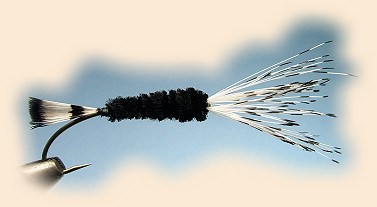The Reversed Spider
By Preston Singletary, WA
Mike Kinney's Reversed Spider was originally tied for the
Stillaguamish River's sea-run cutthroat but has proven to
be highly effective, not only in other rivers for cutthroat
and steelhead, but also in salt water for cutthroat, coho
and even Chinook salmon. It is a style of fly rather than
an individual pattern and can be tied in a wide variety of
colors and many different kinds of feathers may be used
for the hackle. Its greatest attraction seems to lie in
the extremely active and seductive movement of the
reverse-tied hackle, I know of no other fly that can even
begin to equal it.
Materials for the Reversed Spider:
Hook: Tiemco 200R, or equivalent, size 6 or 8.
Thread: 6/0 black (or to match body color).
Body: Medium chenille.
Hackle and Tail: Lady Amherst pheasant tippet, golden
pheasant tippet, dyed or natural mallard flank or any
well-marked duck flank, such as wood duck, teal or gadwall.
Tying Instructions for the Reversed Spider:
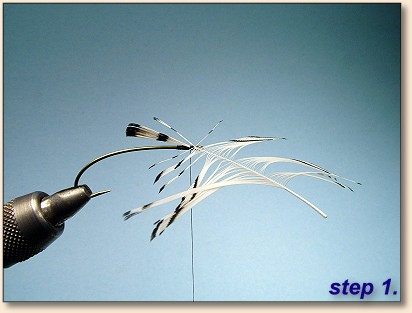
1. Build a short thread base right behind the eye of
the hook. Select an Amherst tippet feather (or other,
see above), strip the lower fibers and the aftershaft
feather and stroke the remaining fibers back, leaving
about 3/4 of an inch of the tip intact. Tie the feather
down immediately behind the eye with 4 or 5 tight turns.
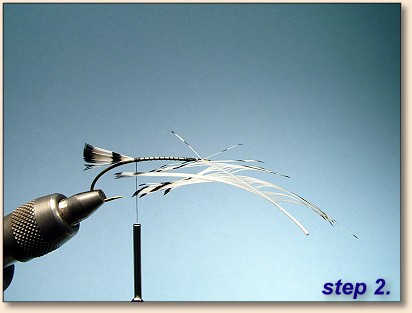
2. Wind the thread back to a point about 1/8 of an
inch ahead of the hook point, snip away the tip of
the feather and tie it in as a tail.
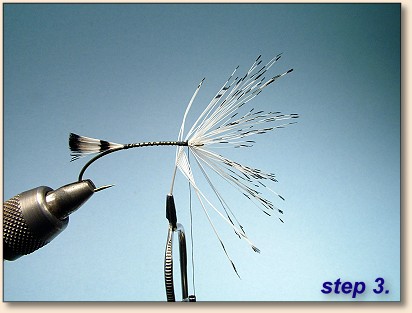
3. At this point the stem of the hackle feather should
be pointing out over the eye of the hook and curving down.
Bring the thread forward to a point close behind the tie-in
point of the hackle feather. Wrap no more than 3 or 4
turns of hackle back along the hook shank, butting each
turn closely up behind the previous one. It sometimes
helps (especially when using a duck flank feather) to
stroke the fibers forward with your free hand as you are
winding. Tie it off with 4 or 5 turns of thread and cut
off the excess stem and fibers.
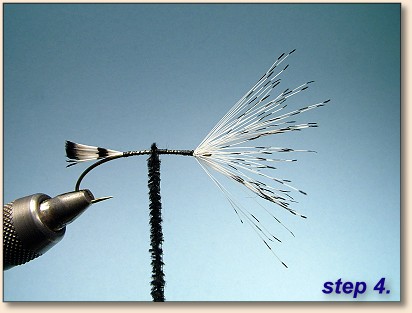
4. Wind the thread back to a point half-way between the
hackle and the tail and tie in the chenille.
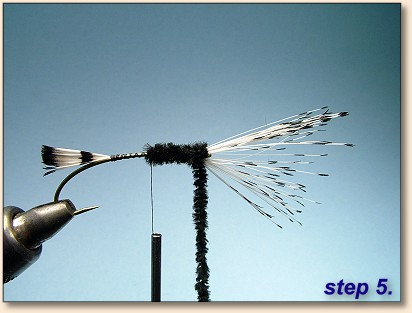
5. Wind the chenille forward and over the butts of
the hackle to a point just behind the eye of the hook.

6. Reverse the direction of the chenille, wind smoothly
back over the first layer and continue to the base of
the tail. Secure the chenille and cut it off, whip-finish
and add a drop of head cement.
The Reversed Spider is a simple pattern and easy to tie;
once you are familiar with the characteristics of the
materials each one should only take a few minutes to
complete. This is fortunate since sea-run cutthroat
like to hang out in a river's snaggiest neighborhoods
and you're bound to have to sacrifice a few flies. As
mentioned above, the Reversed Spider represents a style,
rather than a single, individual fly. In addition to
the fly shown above, some of my favorites include: hot
orange body/wood duck (or wood duck-dyed mallard) hackle,
black body/yellow-dyed Amherst tippet hackle and yellow
body/golden pheasant tippet hackle.
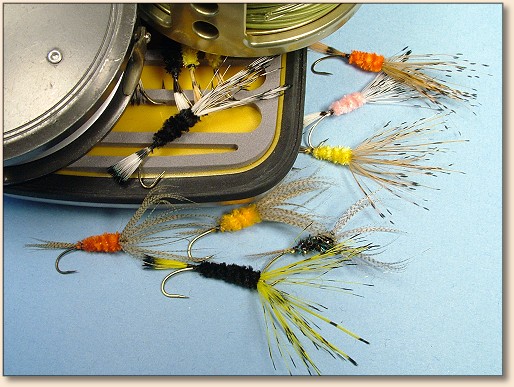
In the rivers, I fish the Reversed Spider on a floating line.
Sea-run cutthroat are very aggressive and I have had them
come straight up out of 10 or 12 feet of water to take this
fly fished no more than inch or two deep. On one occasion
it even elicited the same response from a summer-run
steelhead which missed it on the first try but was hooked
on the very next cast. In salt water I have had the most
success fishing it on an intermediate-sink line.
Since sea-run cutthroat are so aggressive, as well as
blindingly fast, Mike Kinney also developed a special
retrieve to use with this fly, one which takes full
advantage of the fly's enticing movement, as well as
keeping the angler in contact with the fly at all times
to reduce the frequency of missed strikes:
Cast the fly across or slightly downstream and mend if
the current so dictates. Holding the rod with its tip
near the surface of the water and the line trapped
between the index finger and the cork of the handle,
lift the rod tip about two feet, using only the wrist.
As soon as the rod tip comes up, immediately drop it
to the surface again while, at the same time, stripping
from behind the right hand, taking in all of the slack
that will be formed by this movement. At first it may
seem a little like trying to rub your stomach while
patting the top of your head but, with a bit of practice,
it quickly becomes second nature. This technique keeps
the fly moving in a consistent series of discrete motions
while allowing little or no slack to form in the line.
This retrieve is also very effective when fishing streamers,
and I have used it in salt water when fishing surface
patterns like Miyawaki's Beach Popper.
About Preston
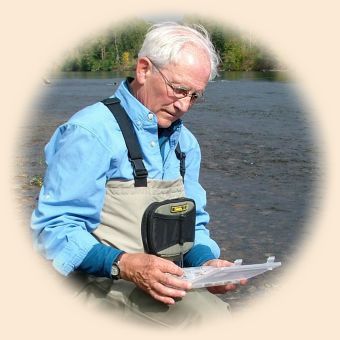 As a native-born Washingtonian, I've fished for salmon,
steelhead and sea-run cutthroat almost as long as I can
remember. Over forty years ago I discovered the pleasures
of fly fishing and never looked back. Having retired
seven years ago from a large aerospace firm, I now have
almost as much free time as I would like,
to spend pursuing those pleasures.
As a native-born Washingtonian, I've fished for salmon,
steelhead and sea-run cutthroat almost as long as I can
remember. Over forty years ago I discovered the pleasures
of fly fishing and never looked back. Having retired
seven years ago from a large aerospace firm, I now have
almost as much free time as I would like,
to spend pursuing those pleasures.
For over ten years now, I have written regular book review
and product review columns as an associate editor of
Flyfishing & Tying Journal. This has not
only made it possible for me to keep abreast of the
literary side of the sport, but to try out the latest
advances in fly fishing equipment as well; an opportunity
for which I am endlessly grateful. You can contact me
at: ~ Preston Singletary
|

